Pain and discomfort below the breastbone or ribs (in the upper abdomen area) is commonly referred to as epigastric pain.
It can occur due to a variety of causes including indigestion, gallstones, acid reflux, bloating etc.
It usually occurs along with other symptoms of digestive issues.
Epigastric pain is not always a serious condition.
Sometimes it can be caused by minor issues such as overeating or lying just after eating heavy meals.
However, in some cases, it can occur due to potential serious causes such as gallstones, infection or inflammation.
These cases require immediate medical attention. Let’s take a look at all the aspects of epigastric pain one by one in detail.
Table of Contents
ToggleEpigastric Pain Types
Stomach pain can be of different types according to the area in which it is occurring e.g., upper abdomen (epigastric), lower abdomen(hypogastric), right-sided abdominal pain and left-sided abdominal pain.

Upper abdominal pain (epigastric pain):
The common causes of upper abdominal pain include digestive troubles.
The pain is experienced in the chest region, back, neck and shoulders. Common symptoms include bloating, acid reflux, heartburn, nausea and loss of appetite.
Lower abdominal pain( hypogastric pain):
Lower abdominal pain is usually caused by constipation, urinary tract infection and menstrual cycle.
The common symptoms include cramps, backache, bloating, painful urination etc.
Right-sided abdominal pain:
Right-sided abdominal pain can be caused by gallstones, liver-related problems or appendicitis.
Common symptoms include sweat and shivers, feeling sick, loss of appetite, diarrhoea etc.
Left-sided abdominal pain:
Left-sided abdominal pain can be caused by kidney stones, kidney infections, or diverticulitis.
Symptoms may include feeling sick, loss of appetite, and pain in the back and genital region.
Epigastric Pain Causes
Epigastric pain can be caused due to a variety of causes. Let’s take a look at them one by one.
Acid reflux:
Acid reflux occurs when acidic fluid from the stomach regurgitates back to the mouth via a food pipe.
When it occurs, it causes pain in the chest and throat. There is pain in the epigastric region with an acidic taste in the mouth and indigestion.
Lactose intolerance:
Some people have lactose intolerance. It causes the inability to digest dairy products such as milk or cheese.
All dairy products contain a sugar known as lactose. The symptoms occur every time a person eats dairy products.
Common symptoms include feeling bloated, stomach pain, nausea, vomiting or diarrhoea.
Alcoholism:
Drinking alcohol over a long period or too much alcohol at once causes damage to protective tissues in the gut.
This will over time cause inflammation, epigastric pain and irritation even bleeding.
Heavy meals:
Overeating causes the stomach to expand and it puts pressure on the surrounding organs.
This may lead to pain and discomfort in the upper abdominal area (epigastric region).
Gastritis:
Gastritis occurs when the stomach lining gets inflamed due to an infection.
It can be acute( sudden in onset) or chronic(gradual in onset).
Common symptoms include pain and discomfort in the upper abdomen or chest area, nausea, vomiting and black tarry stools.
Peptic ulcer:
The protective lining of the stomach and intestine may get inflamed due to overuse of painkillers, NSAIDs or an infection that can lead to the development of a peptic ulcer.
Hiatal hernia:
When a part of the stomach gets pushed upwards through a hole in the diaphragm then it is known as a hiatal hernia.
It may cause pain and discomfort in the epigastric region.
It causes symptoms like burning in the chest, loud burping, irritated and sore throat and indigestion.
Gallbladder inflammation and gallstones:
In some cases, the gallbladder gets inflamed and gallstones block the opening of the gallbladder which may cause sudden and severe epigastric pain.
Common symptoms of gallbladder stones are low appetite, nausea, vomiting or bloating, clay-coloured stools, yellowish skin or high fever.
Epigastric pain in pregnancy:
Mild epigastric pain is a common feature in pregnancy. Changes in hormones, digestion and increasing belly can lead to pain in the upper abdomen.

Epigastric Pain Symptoms
Epigastric pain causes discomfort in the upper region of the abdomen just below the breastbone.
Some people may experience bloating and indigestion issues.
Mild pain and bloating are common symptoms experienced by patients.
In some cases, such as epigastric pain due to gallstones, the patient may suffer from severe attacks of pain below the breastbone.
Sometimes, epigastric pain can become a medical emergency.
Constipation or diarrhoea can occur along with epigastric pain.
Some patients might experience pain in the jaw, neck and shoulders along with pain in the upper abdomen and chest.
Risk Factors for Epigastric Pain
Certain risk factors make a patient more prone to get affected by epigastric pain.
Hiatal hernia:
People who suffer from hiatal hernia can experience frequent episodes of epigastric pain.
Sedentary lifestyle:
People who live a sedentary life and do not include physical work in their routine may suffer from indigestion issues and acid reflux. This may lead to epigastric pain.
Peptic ulcer:
A peptic ulcer can damage the protective lining of the gut and also lead to digestion issues including pain in the upper abdomen.
Alcohol:
People who drink too much alcohol are at a higher risk to suffer from epigastric pain.
Gallbladder disorders:
People with gallbladder disorders experience frequent episodes of pain in the epigastric region, back, neck and shoulders.
Pregnancy:
Mild epigastric pain is very common in pregnant women.
Diagnosis
The doctor will take the whole medical history and symptoms details and make the diagnosis of epigastric pain.
However, to detect the exact cause of the epigastric pain, the doctor may advise certain investigations and tests.
Blood test:
The blood test can be advised to detect infection in the body.
USG:
USG abdomen can be done to rule out the presence of a hernia, appendicitis, or gallbladder-related issues.
X-RAY:
X-RAY can be done to detect the presence of gallbladder stones.
Epigastric Pain Management
Certain management tips can help to minimise the symptoms of epigastric pain.
Let’s take a look at them one by one.
Avoid alcohol:
Alcohol should be completely stopped to avoid epigastric pain in alcoholic people.
Don’t overeat:
Try to eat in moderation and don’t overeat to avoid the attacks of epigastric pain.
Exercise:
Include physical activity or exercise in your daily routine to stay fit and avoid indigestion issues.
Treat underlying diseases:
Treatment of underlying diseases such as gallstones or gallbladder inflammation, peptic ulcers, and appendicitis should be treated under proper medical supervision.
Best Homeopathic Medicines for Epigastric Pain
Homeopathy offers a safe, gentle and reliable treatment option for patients who suffer from epigastric pain.
There are so many beneficial remedies in homeopathy that are completely capable of treating epigastric pain.
Let’s take a look at the top indicated remedies for epigastric pain in homeopathy one by one in detail.
1. ABIES NIGRA: For epigastric pain after eating
Symptoms:
Abies Nigra is one of the best medicines in homeopathy for the treatment of epigastric pain which occurs after eating.
There is a sensation of a lump that hurts or a hard-boiled egg lodged in the centre of the upper abdomen.
The patient experiences continual distressing constriction just above the pit of the stomach as if everything were knotted up.
The patient has a total loss of appetite in the morning but a great craving for food at noon and night.
There is offensive breath with eructations.
Potency and dosage:
Abies Nigra 1M can be taken as four pills or drops once a week till improvement occurs. Abies Nigra 200CH can be taken as four pills or drops once daily till improvement occurs.
Abies Nigra in 30CH can be taken as four pills twice daily till improvement occurs.
2. CARBO VEG: For contractive epigastric pain with bloating
Symptoms:
A Carbo Veg patient experiences eructations, heaviness and fullness in the abdomen.
There is much gas and the symptoms become worse on lying down.
The patient complains of eructations after eating and drinking with temporary relief after belching.
There is nausea in the morning. Burning in the stomach extends to the back and spine.
There is contractive pain extending to the chest with distention of the abdomen.
The is cramping in nature, forcing the patient to bend double.
Potency and dosage:
Carbo Veg 1M can be taken as four pills or drops once a week till improvement occurs. Carbo Veg 200CH can be taken as four pills or drops once daily till improvement occurs.
Carbo Veg in 30CH can be taken as four pills twice daily till improvement occurs.
3. NUX VOMICA: For epigastric pain several hours after eating
Symptoms:
The patient complains of a sour taste in the mouth with nausea in the morning after eating.
There is weight and pain in the stomach several hours after eating.
The patient feels nausea and vomiting with much retching.
The stomach region is very sensitive to touch. The upper abdomen feels bloated with the pressure of stones.
The patient is having a desire for stimulants. He loves fat and tolerates them well.
It is helpful medicine for the treatment of epigastric pain in alcoholics.
Potency and dosage:
Nux Vomica 1M can be taken as four pills or drops once a week till improvement occurs. Nux Vomica 200CH can be taken as four pills or drops once daily till improvement occurs.
Nux Vomica in 30CH can be taken as four pills twice daily till improvement occurs.
4. COLOCYNTH: For epigastric pain causing the patient to bend double
Symptoms:
There is an agonizing and cutting pain in the abdomen. There is a sensation as if stones were grouped in the abdomen and would burst.
The patient experiences colic pain in the abdomen, especially after anger.
Every attack is attended with general agitation and a chill over the cheeks ascending from the abdomen.
Least food or drink causes diarrhoea. The patient complains of distension in the abdomen with bloating.
When these symptoms match, colocynth can completely cure epigastric pain.
Potency and dosage:
Colocynth 1M can be taken as four pills or drops once a week till improvement occurs. Colocynth 200CH can be taken as four pills or drops once daily till improvement occurs.
Colocynth in 30CH can be taken as four pills twice daily till improvement occurs.
5. DIOSCOREA: For sharp pain in the epigastric region
Symptoms:
Dioscorea is one of the top-indicated medicines for epigastric pain in homeopathy.
There is belching of large quantities of offensive gas. The patient experiences sinking at the pit of the stomach.
The pain suddenly shifts to different parts. There is rumbling in the abdomen with much flatus.
There is gripping and cutting pain in the hypogastric region with cutting pains in the intestines.
The pain is better by walking. The pain radiate to the back, chest and arms and becomes worse on bending forward.
The symptoms are better by standing erect. There is a hurried desire for stool.
Potency and dosage:
Dioscorea 1M can be taken as four pills or drops once a week till improvement occurs. Dioscorea 200CH can be taken as four pills or drops once daily till improvement occurs.
Dioscorea in 30CH can be taken as four pills twice daily till improvement occurs.
6. ROBINIA: For epigastric pain with acid reflux
Symptoms:
It is a helpful medicine for patients who suffer from epigastric pain with indigestion issues.
Acidity is the most prominent symptom of this medicine. The acidity is accompanied by a frontal headache.
There are intense acrid eructations with acrid and greenish vomiting.
There are nightly burning pains in the stomach with constipation.
The patient experiences great distension of the stomach and bowels.
Potency and dosage:
Robinia 1M can be taken as four pills or drops once a week till improvement occurs. Robinia 200CH can be taken as four pills or drops once daily till improvement occurs.
Robinia in 30CH can be taken as four pills twice daily till improvement occurs.
7. MAGNESIA PHOS: For epigastric pain relieved by warmth and pressure
Symptoms:
The patient complains of hiccoughs with retching day and night.
The pain in the abdomen is relieved by pressure. There is much gas in the abdomen forcing the patient to bend over double.
Symptoms of a Magnesia Phos patient are relieved by warmth and pressure.
There is a bloating sensation in the abdomen, must relieve the cloth and walk about to get some relief.
There is constipation in people who suffer from joint pains due to the accumulation of gas and indigestion.
Potency and dosage:
Magnesia Phos 1M can be taken as four pills or drops once a week till improvement occurs. Magnesia Phos 200CH can be taken as four pills or drops once daily till improvement occurs.
Magnesia Phos in 30CH can be taken as four pills twice daily till improvement occurs.
8. PULSATILLA: For epigastric pain with shirtlessness
Symptoms:
There is a great aversion to fat, warm food and drink. There are eructations with a taste of food remaining after a long time.
The patient experiences heartburn with indigestion issues. There is a tightness in the abdomen after a meal. The patient is thirstless with nearly all complaints.
There is vomiting of food eaten long before with pain in the epigastric region.
Potency and dosage:
Pulsatilla 1M can be taken as four pills or drops once a week till improvement occurs. Pulsatilla 200CH can be taken as four pills or drops once daily till improvement occurs.
Pulsatilla in 30CH can be taken as four pills twice daily till improvement occurs.
9. LYCOPODIUM: For epigastric pain with excessive hunger
Symptoms:
Lycopodium is a very useful medicine for patients who suffer from epigastric pain with excessive hunger.
The patient is having a desire for sweet things with a sour taste in the mouth.
This is a great weakness of digestion. After eating there is pressure in the abdomen with a bitter taste in the abdomen.
Eating ever so little creates fullness in the stomach. The patient wakes up at night feeling hungry.
He likes to take food and drink hot. Immediately after a light meal the abdomen feels bloated and full.
Potency and dosage:
Lycopodium 1M can be taken as four pills or drops once a week till improvement occurs. Lycopodium 200CH can be taken as four pills or drops once daily till improvement occurs.
Lycopodium in 30CH can be taken as four pills twice daily till improvement occurs.
10. CHINA: For epigastric pain due to gallbladder issues
Symptoms:
China is one of the best medicines for the treatment of epigastric pain due to gallbladder issues.
The stomach is tender and cold with vomiting of undigested food.
Digestion is slow with a sensation of weight after eating. The patient is hungry without appetite.
Bloatedness is better by movement. There is much flatulent colic which is better by bending double.
When these symptoms match, Colocynth can completely cure the case.
Potency and dosage:
China 1M can be taken as four pills or drops once a week till improvement occurs. China 200CH can be taken as four pills or drops once daily till improvement occurs.
China in 30CH can be taken as four pills twice daily till improvement occurs.
Remember that homeopathic remedies are prescribed based on individual symptoms and characteristics. It’s crucial to consult with a qualified homeopath for proper evaluation and personalized treatment. Homeopathy focuses on treating the whole person, so a detailed case study is necessary to select the most appropriate remedy.
Homeopathic medicines should be taken only when prescribed by a homeopathic physician. Self-medication may aggravate the original conditions.

